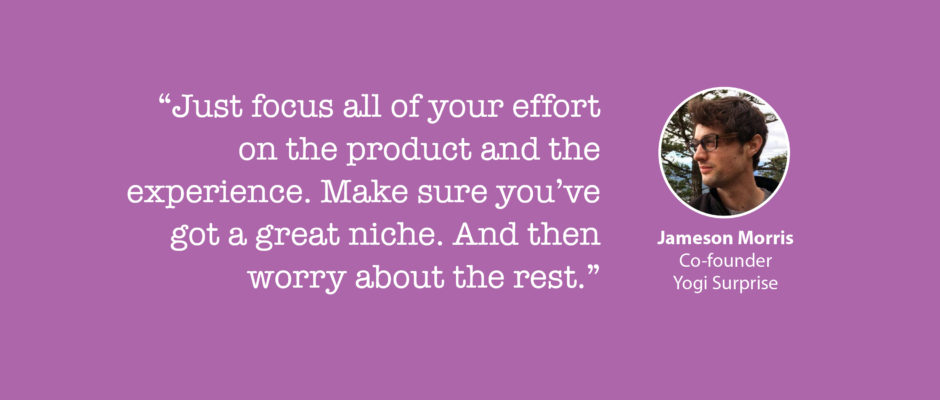You can also check out this interview on the SaaS Open Mic Podcast:
https://soundcloud.com/chartmogul/jameson-morris-on-creating-a-subscription-box-empire
How it all began
Ed: One thing that I’m excited to chat about with you is that you deal not in software but with actual physical subscription products. To give people a better picture of what you do, I was wondering if you could just describe yourself to someone else.
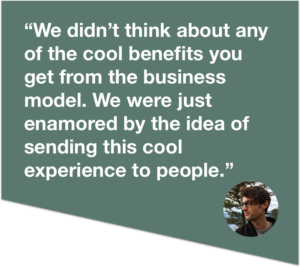 Jameson: Well, basically at this point in my career, I would describe myself as a serial subscription or subscription box entrepreneur. It’s basically all I’ve been doing over the last several years. I haven’t had a month in 5 years that didn’t have a subscription box product being shipped out. So I’ve started several subscription boxes, I held a role at CrateJoy, which is a platform for subscription boxes. Then I actually ended up leaving CrateJoy to focus on another subscription box business. My current business is the subscription box, Yogi Surprise.
Jameson: Well, basically at this point in my career, I would describe myself as a serial subscription or subscription box entrepreneur. It’s basically all I’ve been doing over the last several years. I haven’t had a month in 5 years that didn’t have a subscription box product being shipped out. So I’ve started several subscription boxes, I held a role at CrateJoy, which is a platform for subscription boxes. Then I actually ended up leaving CrateJoy to focus on another subscription box business. My current business is the subscription box, Yogi Surprise.
Ed: Why subscription boxes? Is there something that drove you to that — was it a conscious decision in the first place or did it just happen?
Jameson: It just happened. My first subscription business was Conscious Box, which started in 2011. When we launched, there was no one else doing it besides Birchbox who had launched their beta at the same time. So when we came up with the idea to do a subscription sampling service for natural products, we just liked the idea of this experience we’re sending to people — packaging it up in this cute little box with nice presentation. We weren’t thinking about any of the other business mechanics that make the model cool. We weren’t think about how recurring revenue is a great thing to have, and the predictability that you can have in these types of businesses. We didn’t think about any of those cool benefits you get from the business model. We were just enamored by the idea of sending this cool experience to people.
Ed: Okay, so it really was a product-first type thing, to put out something that drives continual value for customers.
Jameson: Exactly. So now people going into it and starting their own subscription box business, they’re hyper-aware of some of the other great benefits of the model. But for us, we weren’t aware of those things. We just thought it was cool to send a box of cool stuff and an experience to people.
Getting started — PMF and MVP?
Ed: The great thing about SaaS is that you can much more easily win a customer and then focus on retention, focus on delivering ongoing value. I’m assuming that’s similar for a subscription box product. Is there anything on your side that makes it more tricky? For example, that it’s a physical product you’re dealing with. And there are logistics involved and you need to source product for that, right?
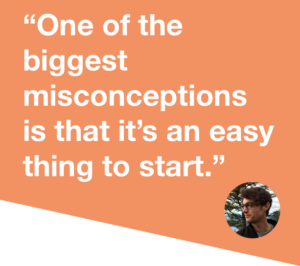 Jameson: Honestly, a Minimum Viable Product doesn’t necessarily exist with consumer subscription. If you’re building a great enterprise software solution with a B2B emphasis, and you have your MVP, and you get a customer who you’re solving some major problem for — but you’re still at an immature stage with your software — that customer is willing to stick around and be patient. But consumers are extremely finicky. They can put their money in so many different places, you know? They’re not going to be patient, they’re not going to hold on until you put together a better impression. With consumers, when you launch, your product has to be totally dialed.
Jameson: Honestly, a Minimum Viable Product doesn’t necessarily exist with consumer subscription. If you’re building a great enterprise software solution with a B2B emphasis, and you have your MVP, and you get a customer who you’re solving some major problem for — but you’re still at an immature stage with your software — that customer is willing to stick around and be patient. But consumers are extremely finicky. They can put their money in so many different places, you know? They’re not going to be patient, they’re not going to hold on until you put together a better impression. With consumers, when you launch, your product has to be totally dialed.
Ed: One thing with software is that there are ways to validate your product idea before you launch it. Does that also exist with this world?
Jameson: Yes. There are great ways to validate these businesses and never be out of pocket. You can totally bootstrap these businesses.The important thing, though, is that you can’t validate them with the product. With Saas products, you can build an MVP and validate to see what interest is like. With a subscription business, you can’t use the product.
There’s a teaser process that I really like going through which is you can tease consumers about the concept, and what you’re planning on building, what you’re going to launch, and collect interest that way. Create mockups and concepts of what the product will be without ever building it. Start taking pre-orders; even Kickstarter has a pre-order feature now which is really nice. When I launched Yogi Surprise, we had 1000 customers the first month because of the teaser pre-launch phase. During that phase, we were just collecting email leads as interest. That gave me the validation I needed to go out and build the rest of the business: setting up fulfillment, the custom packaging, actually starting to build the website, etc. So there certainly is a great way to validate these businesses, but you have to be a bit more creative about it.
Ed: I assume you have a small team working with you on your subscriptions. I’m curious to know what a team looks like, or if it’s possible to do this completely solo. How does that look?
Jameson: Yeah, Yogi Surprise is a ridiculously small team. It’s basically just me and my co-founder. And I have customer service outsourced, actually to my sister-in-law. I pay her per solved ticket which is a cool way to do customer service. Then we have a couple contractors here and there that do things for us. Obviously engineering is totally with freelancers; we have no need for a full-time.
 But yeah, we manage a fairly decent sized subscription business on our own, and
But yeah, we manage a fairly decent sized subscription business on our own, and
we like the way it’s been built as a sort of lifestyle business. We’ve gotten really good at automating as much as we can and standardizing our monthly workflow. We have everything in a calendar, checklists, and reminders. We’ve built it as a nice lifestyle business. It’s how I like these businesses and how I think that they should be. I don’t think they’re meant to be $100M venture-backed businesses. But I think they make really great lifestyle businesses — and once you get them dialed and the logistics and the processes down, they become really sweet businesses.
Ed: Related to that, I noticed on your website that you basically advise to not raise venture capital. “Most subscription business can survive with extremely low overhead. Don’t raise venture capital.” I’m curious about that. Have you ever raised venture capital for any of your businesses? Is this piece of advice something you learned along the way, or were you just able to build these businesses without?
Jameson: Yeah, I think most people who say “don’t raise venture capital” have done it and had a bad experience. So, yeah. My first business Conscious Box, we grew it to a few thousand subscribers on our own, me and just the couple co-founders. And we were seeing some success, and we thought the natural direction to go was to raise venture capital. So we built this whole story of how this could be a $100M business, tacking on other parts to growing the business model beyond the monthly box. We built this whole narrative and ended up raising about $3M.
It’s a long story, but at the end of the day now, I’m just really not a fan of raising venture capital. I see a totally different direction that business could have taken, which would have resulted in that business still existing today, which it doesn’t. The way that I built my next few businesses reflects how I feel they should have been done.
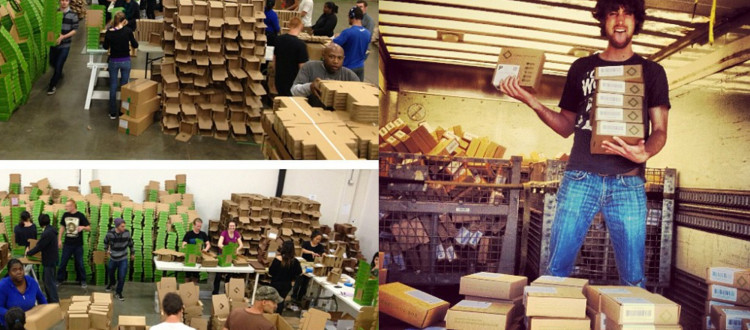
Measuring a subscription box business
Ed: I assume like any subscription product, it’s measurable. There are metrics you can use to make the whole thing measurable. You mentioned from the beginning that wasn’t a primary reason for you guys — you just wanted to provide a great experience for customers. Do you use a lot of metrics now? And if so, what’s important to you?
Jameson: We weren’t even aware of the concept of churn and retention and its relationship to the product or customer service. So now I measure everything, and I keep a very close eye on monthly retention. But also we’re measuring Net Promoter Score every month, always sending out customer satisfaction surveys. Those are some of the key things to look at to make sure your business is healthy and going in a sustainable direction.
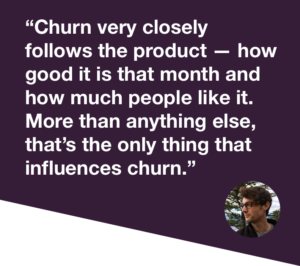 But in a subscription business, because it’s so consumer-oriented, everything revolves around the product and the experience. If we want to talk about common mistakes: it’s slacking on the product. A lot of people will start these things with the mentality like, “Alright, I gotta get it up, I gotta get it launched. Let’s open the doors and let people start buying.” But what they do is they validate their businesses in the wrong way; they rush to launch. And they don’t spend time doing nice custom packaging, they don’t spend time on the experience. They don’t invest in some of those really important product decisions that will drive the business and make or break it. You get a lot of people saying, “I want to launch and get my first 200 customers — and once I have some cash, then I’ll invest in doing nice custom packaging and working on the experience.” And it’s a totally backward approach.
But in a subscription business, because it’s so consumer-oriented, everything revolves around the product and the experience. If we want to talk about common mistakes: it’s slacking on the product. A lot of people will start these things with the mentality like, “Alright, I gotta get it up, I gotta get it launched. Let’s open the doors and let people start buying.” But what they do is they validate their businesses in the wrong way; they rush to launch. And they don’t spend time doing nice custom packaging, they don’t spend time on the experience. They don’t invest in some of those really important product decisions that will drive the business and make or break it. You get a lot of people saying, “I want to launch and get my first 200 customers — and once I have some cash, then I’ll invest in doing nice custom packaging and working on the experience.” And it’s a totally backward approach.
You really have to forget about technology, forget about all the different apps you’re going to use — just focus all of your effort on the product and the experience. Make sure you’ve got a great niche. And then worry about the rest.
Ed: That makes sense. You mentioned that you measured churn. Do you break that down by any specific dimensions? Do you look at Customer Lifetime Value? What are the really important views of your data that you see?
Jameson: I don’t really look at Customer LTV. I get what I need from Churn. I know my Costs of Goods, I know what my margins are, so I can kind of back into an LTV with what my monthly churn is going to be. I use that for two things. The first is to determine what I can spend on customer acquisition, how many months of profit I can spend on acquiring a new customer. But I also noticed that churn very closely follows the product — how good it is that month and how much people like it. More than anything else, that’s the only thing that influences churn. I think for others customer service is a huge influence on that number. But customer service, from Day 1, has always been a top priority for us. We go above and beyond. So, with our business Yogi Surprise, the only thing that changes that number is going to be the product quality.
Ed: By that you mean effectively what’s in the box?
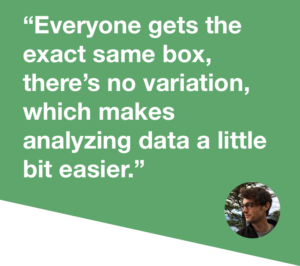 Jameson: Yeah, that month’s experience, you know? If I did a bad job procuring product for that month, or I slacked, or wanted to keep a little extra money and get greedy and keep some product out of the box — that number’s going to change.
Jameson: Yeah, that month’s experience, you know? If I did a bad job procuring product for that month, or I slacked, or wanted to keep a little extra money and get greedy and keep some product out of the box — that number’s going to change.
Ed: That’s interesting. So I guess something like a Cohort Analysis chart is totally different to you because every month you effectively have a different product in some ways. And looking at churn trends month by month, I guess if you see a spike in churn in a given month that’s more an indicator that what you shipped that month didn’t really resonate with people or wasn’t up to scratch. Whereas with a software business, it’s more about what their experience was at that point in time. Like, “What was the customer doing at month 3 that gave them a bad experience?”
Jameson: Right. Each month I can look at it and know which product went out. Everyone gets the exact same box, there’s no variation, which makes analyzing data a little bit easier. The one thing that’s nice is looking at churn by customer acquisition channel. If I do a big campaign to a new audience that’s not quite on-niche, or give a deep discount to a new audience that month — depending on the quality of that audience and how closely it’s tied to our niche, it can dramatically affect churn.
But for our business, churn or retention has been very consistent since the beginning. I know that unless I do something dramatic with the product, that nothing’s going to change. Or I know that unless I do something with a customer that’s unsustainable or not smart customer acquisition, then it will change.
The subscription box economy is not a bubble
Ed: I guess things were a bit different back when you started Conscious Box to how they are now, and there’s been a lot of growth in the space. How do you see the subscription box space now? Is there room for new business there and are people still generating innovative products and ideas?
Jameson: Totally. I would guess there are about 2000 subscription boxes that exist. And by “subscription box”, I’m referring to a consumer-oriented product, that is physical and shipped to the customers house on a recurring basis, usually month to month.
Yeah, a lot of people ask me: Is this a bubble? Is it saturated? Should I still get into this space? And I say, just because it’s popular doesn’t mean it’s a bubble. I do think we’re going to see less and less of the big venture bets that are happening. And in general, I think it’s a superior form of e-commerce.
Ed: You say you think we’re nowhere near saturation and that we’re not in a bubble in this space. How do you see the future panning out for these types of products?
Jameson: A consumer subscription can have a ton of different models, and it can apply to almost any niche. My gut says that we’re going to see more and more makers, and artisans and people with specific expertise, creating subscription products that they’re passionate about or that they’re knowledgeable about.
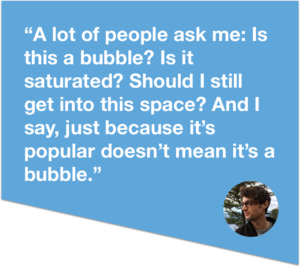 My sister is a good example. She started a speciality sprouted granola subscription. It’s something she handcrafts, she’s super knowledgeable about sprouting, and it’s a specialty product that you can’t get in stores and probably can’t find anywhere. And she’s built up a great little loyal base of people that love to receive it on a recurring basis. So I think we’ll continue to see the model being applied in that fashion. And it makes such a great lifestyle business for just everyday people who are either trying to quit their day jobs or trying to monetize something that they make, that they’re really good at creating.
My sister is a good example. She started a speciality sprouted granola subscription. It’s something she handcrafts, she’s super knowledgeable about sprouting, and it’s a specialty product that you can’t get in stores and probably can’t find anywhere. And she’s built up a great little loyal base of people that love to receive it on a recurring basis. So I think we’ll continue to see the model being applied in that fashion. And it makes such a great lifestyle business for just everyday people who are either trying to quit their day jobs or trying to monetize something that they make, that they’re really good at creating.
I think in that sense it’s a great business for first-time entrepreneurs. Especially with all the tools available now that make it so much easier. When we started our first subscription back in 2011, we were creating best practices. We had no idea the correct way to run these businesses. And all the information that’s online now, from Subscription School to my blog, is from years of wasting money and making bad decisions. So, if you’re starting a subscription business now, there’s no reason why you should get it wrong.
A great model for a first-time entrepreneur
Ed: So this is something that’s accessible for first-time founders or young entrepreneurs to get into as a first venture?
Jameson: I think now more than ever, it’s definitely approachable for a first-time founder or someone starting their first business. There are a lot of great tools out there that make it easy. You’ve got ChartMogul that gives you great transparency into the metrics of your business, but you’ve also got CrateJoy who has done a lot of work making the model approachable. They provide an all-in -one Shopify-style platform that gives you all the pieces to do it. And like I said, you’ve got more resources — you’ve got people like me blogging about best practices. And you’ve got Subscription School. So, it’s a lot more approachable.
One of the biggest misconceptions is that it’s an easy thing to start. On the surface, it seems pretty simple, right? You get a box of products and you send them to people, and you rebuild them every month. But there are a lot more moving pieces that people aren’t aware of, a lot of logistical challenges — timing is huge. So there’s a lot you can get wrong. But now more than ever before, there are a lot of tools and resources out there. And once you nail your first one, it becomes a lot easier to do again.
Ed: For someone totally new to the game, what tools would you recommend?
Jameson: In terms of technology and applications, I definitely recommend using an all-in-one system like CrateJoy. If you don’t do that, you’ll have to put a bunch of pieces together, which can be hard. Also having a really good view of the data surrounding your business and metrics from day one is really important, and understanding basic concepts like retention and how your product can influence that.
Deliver what you love
Ed: You mentioned people are moving into a much more niche spaces and communities for subscription boxes. How would you go about finding that niche and finding a space that’s suitable for a new subscription box product?
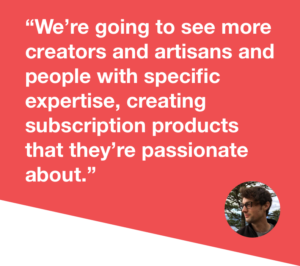 Jameson: I guess I can highlight my path with that. I kind of got lucky — because I’ve started several subscription businesses at this point and my three main ones have been successful. And I got lucky because my thought process always started with, “What do I like? What things am I passionate about?” — and then that leads to, “How can I monetize this?”
Jameson: I guess I can highlight my path with that. I kind of got lucky — because I’ve started several subscription businesses at this point and my three main ones have been successful. And I got lucky because my thought process always started with, “What do I like? What things am I passionate about?” — and then that leads to, “How can I monetize this?”
You get a lot of people who have an opposite approach, where they’re like, “Where is the opportunity? What’s the business that I can start?” And so the first thing I recommend is to really think about what you like, what niches, what products, what things you have knowledge about and go from there to determine your niche.
With Yogi Surprise, my most recent subscription, yoga is something I actively practice. I like yoga consumer products. I’ve always been a fan of that category. And in the past, I think I never started a subscription in the yoga category because I thought it was too niche. I was totally wrong. So one of the biggest lessons I’ve learned is to think of a category and then think of an even tighter community within that category, and go there.
Wrapping up
Ed: So I’m completely sold on this subscription box thing now. I don’t know why I try to cut down on the number of recurring subscriptions that I have but… Are you a subscription consumer as well? Can you recommend any subscription boxes that I should have in my life?
Jameson: I’ve actually never subscribed to a subscription, which is kinda funny. I think part of it is because I’ve been doing it for so long, and the magic isn’t there. In my first business, we were packing these boxes in our house, and we’d do it in one apartment one month, then in someone’s garage. We weren’t outsourcing fulfillment; we were doing it all by hand. So I think the magic, the reason people love these so much, just wasn’t there for me. Except! The first subscription that I really wanted to subscribe to, which I’m still going to do, is the Robb Vices subscription. It’s like a luxury subscription box where you get these really cool, rare things each month. It’s started by luxury magazine media company, The Robb Report.
Ed: Okay, cool. I’ll check that out. Well, it’s been really great to talk to you, Jameson. There’s a ton of stuff here that’s not only actionable for people who run subscription boxes or are interested in starting their own — but I think it’s also interesting to see the contrast and some of the similarities to SaaS as well.
If people want to check out your writing, where’s the best place for people to read that stuff?
Jameson: Ah, you can check out my blog, JamesonMorris.com. Jameson spelled like the whiskey. All I do on that blog is write about subscription box best practices.
Ed: Awesome. Thanks for taking the time!
